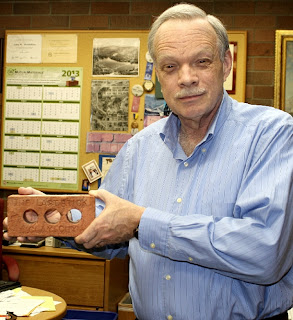“Absentee ownership never works. People assume you don’t
want it anymore.” These are words of advice from Jeff Linstad, manufacturing
engineer for Mutual Materials, who oversaw the demolition of Clay City.
 | ||
| Houlahan holds one of the last bricks made in Clay City. |
The plant made its last brick in January of 1994, but it was
not completely demolished until September of 2003, and during the ensuing
years, it underwent a variety of interesting unauthorized uses.
“When we shut the
plant down, we didn’t realize what people would do,” Mutual Materials President
Gary Houlahan said. “We couldn’t afford to keep someone there for security, and
some crazy things happened.”
Company personnel tried to secure the site by putting up
signs and fences. Initially, they couldn’t close the Clay City Road because it was a
dedicated county right of way, but Linstad hired a company to make a chain link
fence to completely surround the plant the year it closed. “It cost us
$24,000,” he said. “Thieves came in and took every last link of that fence.”
Then, Houlahan said, “Some enterprising fellows set up a
meth lab in one of the buildings there. They weren’t particularly bright
though, because hunters and a lot of people were still walking through that
area, and somebody reported them to the police.”
 |
|
This photo of a kiln from the Dispatch shows that the plant
was still in
decent condition in 1996, as large scale unauthorized salvage
operations had not yet begun.
|
According to an account in the August 21, 1996, Eatonville
Dispatch, a nearby property owner had earlier confronted one of the young men
who was wearing camouflage gear and holding a shotgun. The property owner told
the man he shouldn’t be on the property, and when the intruder didn’t respond,
the neighbor called the Pierce County Sheriff’s Office. Twenty officers showed
up and found three men in the final stages of producing a batch of methamphetamine.
Around the same time, a former employee at the brickyard
formulated rumors that the clay mines contained gold. He started an
organization that advertised tours to this gold-rich land. Paying customers
would dig up clay and take it down to the river to pan for gold. What they
didn’t know is that the organizer had
sprinkled small amounts of gold dust in the bottom of the pans, enough to keep
the customers interested but not enough to cut into the enterprise’s profits.
Once Mutual Materials heard about the scheme, they forced it to shut down.
The meth lab and gold mine didn’t end the illicit activities
at Clay City, though. The buildings were still mostly intact, and while the
furniture had been removed by Mutual Materials, valuable items remained in the
walls and machines for someone experienced in salvage operations.
“After that, a group of professional thieves came in and
changed the lock on the gate,” Houlahan explained. “They would open it up
during the day and steal everything of value—copper wire and copper from the
radiators, especially, but also fixtures, doors, lumber—anything on the
buildings they could tear apart and sell. They were operating on a regular
40-hour work week. During daylight hours, they’d drive their trucks in and go
to work. At the end of the day, they’d lock the gate back up until the next
morning. It was kind of funny, in a sad sort of way.”
 |
|
Some of the vandalism of the plant can be seen
in this photo
from Jeff Linstad of Mutual Materials.
|
Besides the professional thieves, there were also hunters
and mischief makers who shot buildings to pieces.
“There had always been a shooting problem there,” Linstad
said. “The plant managers would call and tell us that hunters were setting up
salt licks within 100 feet of the plant to attract the deer for easy kills.”
But the problem escalated after plant closure. “The school bus driver didn’t
want to drive the bus past the gate because kids on the bus might be hit by
stray bullets,” Linstad said.
“People shot their names in bullet holes in the roof of the
clay shed,” Houlahan said. “They’d shoot at some areas repeatedly to try to
make small holes bigger.” Some of the destruction was also done, apparently, by
sledgehammers, with vandals breaking apart brick smoke stacks and pillars in expectation
of watching them tumble down, though from photos Linstad took of the damage, rebar usually prevented brick walls from falling.
 |
| This 2003 photo from Linstad shows the dismantling and leveling of the plant. |
Mutual Materials realized that the only way to discourage
thieves and trespassers was to completely dismantle the plant and level the
site, which it completed in 2003. The company was able to recover and sell the
pug mill, the machine that actually made the bricks, because it was too heavy
for thieves to salvage. Now nature has taken over and traces of Clay City are
slowly disappearing. The company did some logging on the site from 2004 through
2008 and then considered converting it to a rock quarry. However, roads to the
site are not ideal and would have been too expensive to upgrade. Also its
distance from metropolitan areas is a problem. In 2011, Mutual Materials put
the 416-acres site up for sale.
---------------------------------------------
For more info about Clay City, see my other two articles:
Memories of Clay City are fading
Traces of Clay City today are scarse
---------------------------------------------
For more info about Clay City, see my other two articles:
Memories of Clay City are fading
Traces of Clay City today are scarse
 |
|
A visitor has tagged the inside of the gate that bars to
road to Clay City with an epitaph.
|






